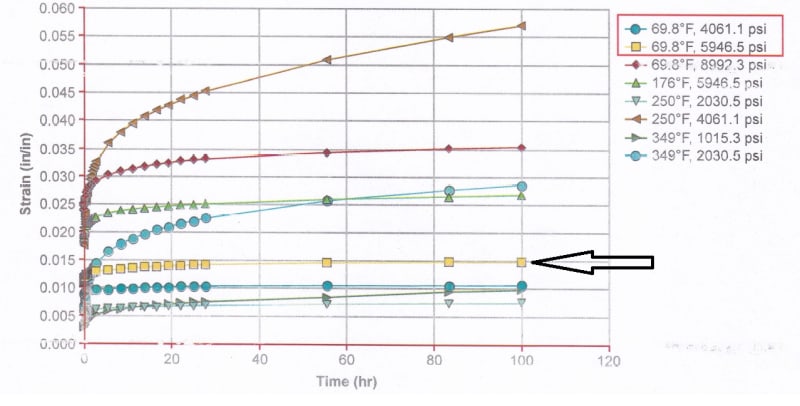elinah34
Mechanical
- Aug 19, 2014
- 149
hello,
I am trying to find out how to evaluate by calculation the anticipated preload decrease as a result of a member creep in my joint.
Here is an illustration on the simplified clamped joint I tried to analyze:

I know that my ULTEM 1000 member is likely to creep and lead to a preload decrease in the bolted joint.
I am attaching a data of SABIC ULTEM 1000 creep in tension (although my case is a compression).
My initial preload is one that leads to a compressive stress of about 5946.5 psi in the ULTEM 1000 member.
I marked the relevant yellow graph which gives data regarding the creep (in tension, unfortunately not compression - but it might be good enough as a limit):

How can I calculate the preload decrease from that point?
I tried to calculate it by myself, but I got something that doesn't seem reasonable - losing the preload entirely.
I am going to detail what were my steps in the preload decrease calculation:
1. From the yellow graph I estimated a maximum of 25% creep (((0.015-0.012)/0.012)*100%).
2. I calculated the additional contract of the ULTEM 1000 member that is the result of creep = 0.25*(member initial strain)*(member thickness).
3. Assuming we maintain contact between the bolt head and nut and the members (and hence the clamping) - the bolt's contract will be equal to it.
This contract will be subtracted from the bolt's initial tension - and this what causes to preload decrease.
4. if we multiply the contract (as a result of creep) by the bolt stiffness, Kb, we get the preload decrease.
As I mentioned above, my calculation doesn't sound reasonable - losing all the preload.
In addition, after looking for a reference in which I can find out how to use the creep graph and calculate the preload decrease, I couldn't find any similar case and such a calculation.
your help will be blessed!
I am trying to find out how to evaluate by calculation the anticipated preload decrease as a result of a member creep in my joint.
Here is an illustration on the simplified clamped joint I tried to analyze:

I know that my ULTEM 1000 member is likely to creep and lead to a preload decrease in the bolted joint.
I am attaching a data of SABIC ULTEM 1000 creep in tension (although my case is a compression).
My initial preload is one that leads to a compressive stress of about 5946.5 psi in the ULTEM 1000 member.
I marked the relevant yellow graph which gives data regarding the creep (in tension, unfortunately not compression - but it might be good enough as a limit):

How can I calculate the preload decrease from that point?
I tried to calculate it by myself, but I got something that doesn't seem reasonable - losing the preload entirely.
I am going to detail what were my steps in the preload decrease calculation:
1. From the yellow graph I estimated a maximum of 25% creep (((0.015-0.012)/0.012)*100%).
2. I calculated the additional contract of the ULTEM 1000 member that is the result of creep = 0.25*(member initial strain)*(member thickness).
3. Assuming we maintain contact between the bolt head and nut and the members (and hence the clamping) - the bolt's contract will be equal to it.
This contract will be subtracted from the bolt's initial tension - and this what causes to preload decrease.
4. if we multiply the contract (as a result of creep) by the bolt stiffness, Kb, we get the preload decrease.
As I mentioned above, my calculation doesn't sound reasonable - losing all the preload.
In addition, after looking for a reference in which I can find out how to use the creep graph and calculate the preload decrease, I couldn't find any similar case and such a calculation.
your help will be blessed!
